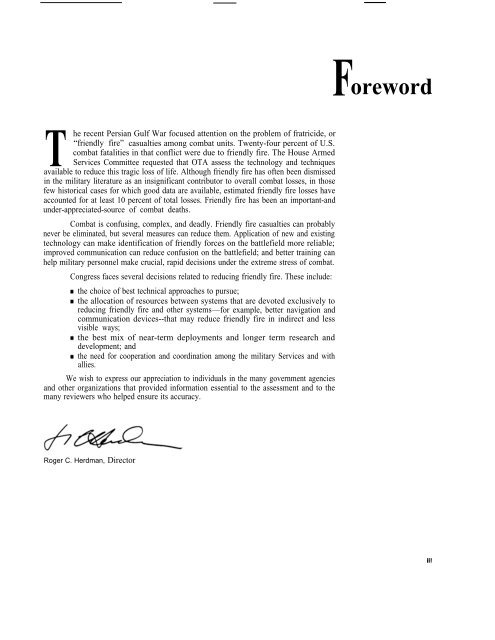Who Goes There: Friend or Foe? - Federation of American Scientists
Who Goes There: Friend or Foe? - Federation of American Scientists
Who Goes There: Friend or Foe? - Federation of American Scientists
Create successful ePaper yourself
Turn your PDF publications into a flip-book with our unique Google optimized e-Paper software.
T<br />
he recent Persian Gulf War focused attention on the problem <strong>of</strong> fratricide, <strong>or</strong><br />
“friendly fire” casualties among combat units. Twenty-four percent <strong>of</strong> U.S.<br />
combat fatalities in that conflict were due to friendly fire. The House Armed<br />
Services Committee requested that OTA assess the technology and techniques<br />
available to reduce this tragic loss <strong>of</strong> life. Although friendly fire has <strong>of</strong>ten been dismissed<br />
in the military literature as an insignificant contribut<strong>or</strong> to overall combat losses, in those<br />
few hist<strong>or</strong>ical cases f<strong>or</strong> which good data are available, estimated friendly fire losses have<br />
accounted f<strong>or</strong> at least 10 percent <strong>of</strong> total losses. <strong>Friend</strong>ly fire has been an imp<strong>or</strong>tant-and<br />
under-appreciated-source <strong>of</strong> combat deaths.<br />
Combat is confusing, complex, and deadly. <strong>Friend</strong>ly fire casualties can probably<br />
never be eliminated, but several measures can reduce them. Application <strong>of</strong> new and existing<br />
technology can make identification <strong>of</strong> friendly f<strong>or</strong>ces on the battlefield m<strong>or</strong>e reliable;<br />
improved communication can reduce confusion on the battlefield; and better training can<br />
help military personnel make crucial, rapid decisions under the extreme stress <strong>of</strong> combat.<br />
Congress faces several decisions related to reducing friendly fire. These include:<br />
the choice <strong>of</strong> best technical approaches to pursue;<br />
the allocation <strong>of</strong> resources between systems that are devoted exclusively to<br />
reducing friendly fire and other systems—f<strong>or</strong> example, better navigation and<br />
communication devices--that may reduce friendly fire in indirect and less<br />
visible ways;<br />
the best mix <strong>of</strong> near-term deployments and longer term research and<br />
development; and<br />
the need f<strong>or</strong> cooperation and co<strong>or</strong>dination among the military Services and with<br />
allies.<br />
We wish to express our appreciation to individuals in the many government agencies<br />
and other <strong>or</strong>ganizations that provided inf<strong>or</strong>mation essential to the assessment and to the<br />
many reviewers who helped ensure its accuracy.<br />
Roger C. Herdman, Direct<strong>or</strong><br />
F<strong>or</strong>ew<strong>or</strong>d<br />
lit
















